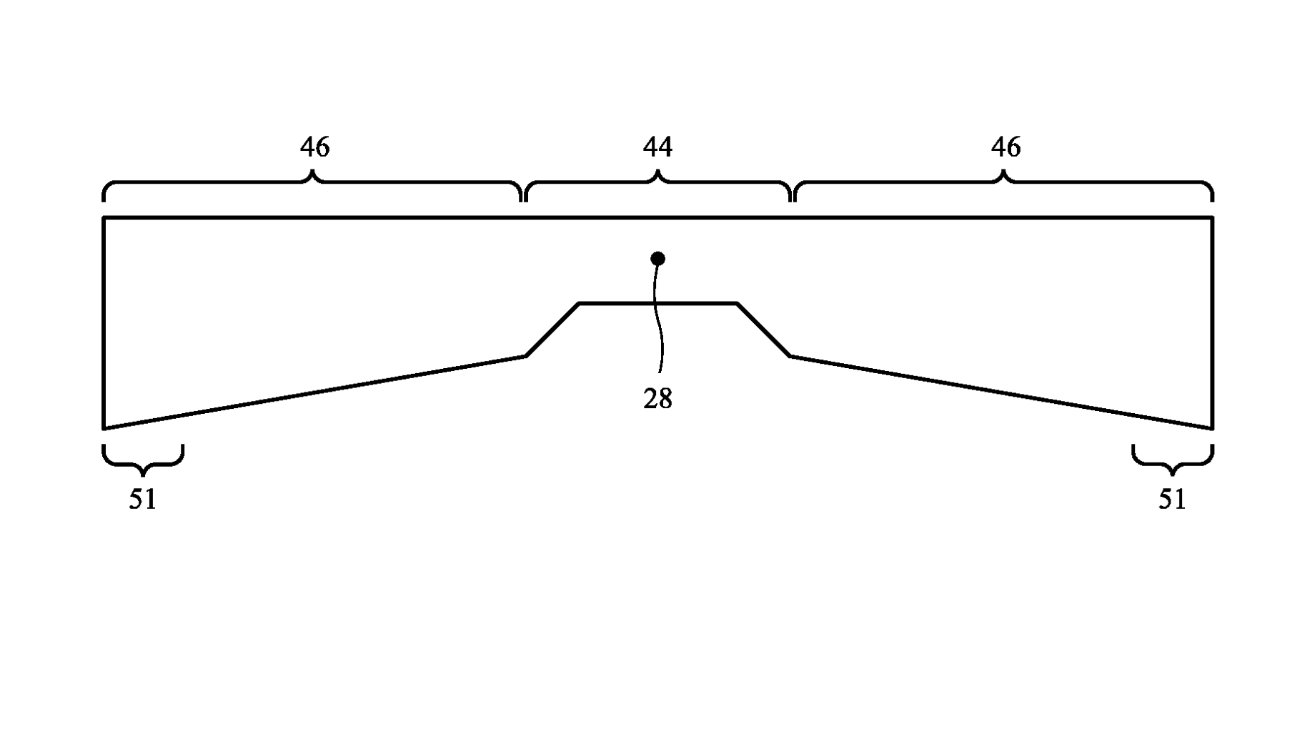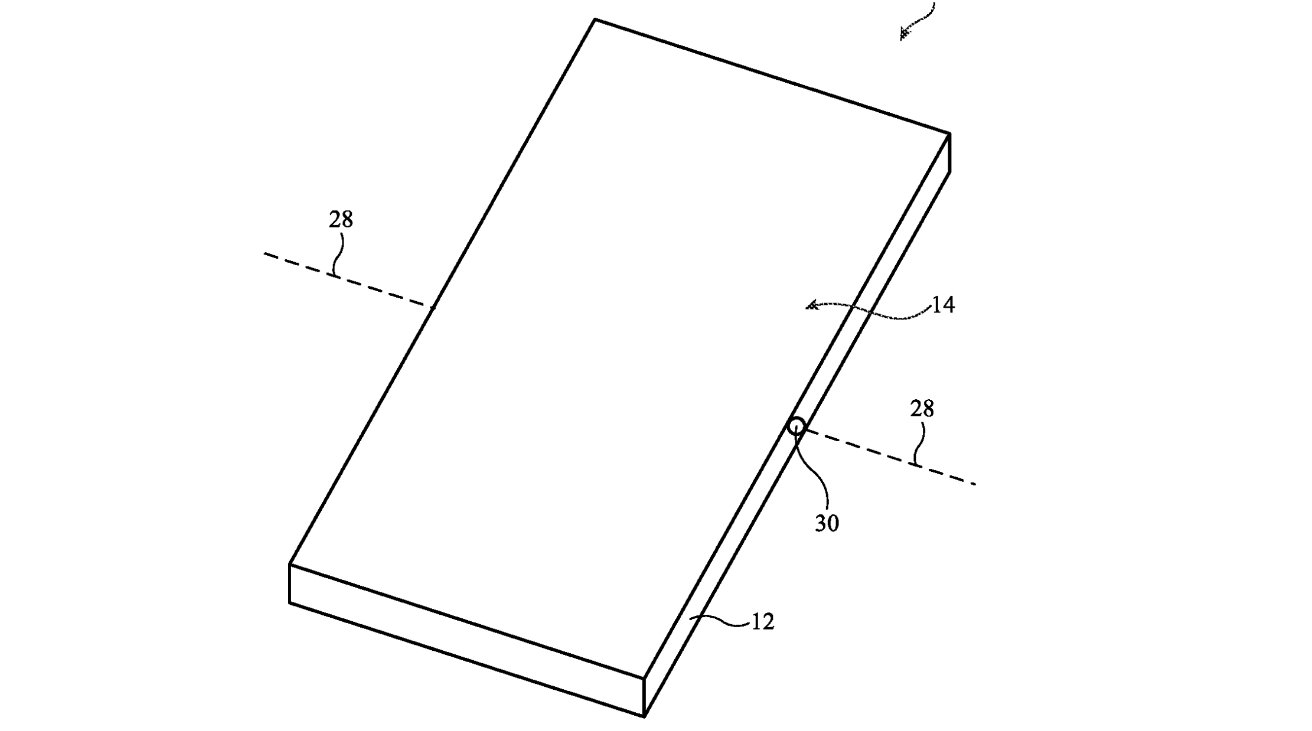Apple gets ever closer to a folding iPhone
The evidence for Apple making a folding iPhone or iPad keeps mounting, and now the company has been granted a patent for a very particular issue with glass displays.

Detail from the patent showing where the thinned part of the display would be
Apart from one rather sketchy claim that Apple has simply given up on an iPhone Fold, normally the rumors say it's nearly here. One report claimed that Apple was currently working on two models, and there have been countless patent applications on the topic.
Now Apple's application for a patent called "Electronic Devices With Durable Folding Displays," has been granted. It's far from a complete plan for a folding display, but it covers a crucial part of how the two halves of a folding display can come together.
"A recess may be formed in the layer of glass that extends along the bend axis," says Apple. "The recess may form a flexible locally thinned portion in the layer of glass that allows the glass layer to bend about the bend axis."
So, Apple's idea is to have a glass display taper directed toward the center. It's possible that Apple is thinking of a foldable display being two regular ones placed on either side of a hinge, but they would still benefit from being made thinner at the key point.
Interestingly, most patents tend to concentrate on one key point, even if they also try to make it sound as if their idea covers a wide range of future possible uses of the proposal. There's an element of that here, but the patent has two key themes.
The first is this business of making the glass thinner for the sections where it needs to bend or intersect. But the second is to take that same display and make its glass thicker.
"To ensure that the display cover layer exhibits satisfactory impact resistance during drop events," continues Apple, "corner portions of the display cover layer and other edge portions of the display cover layer may be provided with greater thickness relative to other portions of the display cover layer outside of the locally thinned portion."

Detail from the patent showing where thinned glass would be needed in an iPhone fold
An iPhone or iPad is likely to suffer the most damage if it is dropped so that a corner hits the ground. So, this might be a case of Apple anticipating future needs and managing to address a current one.
Note that Apple applies for thousands of patents every year. Even when one is granted, it does not mean that a product will definitely be made using it.
Read on AppleInsider

Comments
Next there’s the reliability aspect. iPhones, and high-end Android phones, are all very solidly constructed these days, with few or no moving parts. But that doesn’t imply even today’s phones are free of physical wear and tear or immune to extreme conditions. Extreme cold or heat will be significant issues to account for in selecting materials and designing folding phones to yield a similar lifespan compared to their non-folding counterparts. For iPhones that implies a five- or six-year lifespan. Not to mention tensile stresses of the folding process itself.
The only viable solution my limited brain can conceive is two separate displays, each pressed up hard against a lip on a hinge to prevent dust or cookie crumbs intruding. As the phone unfolds, at the last part of the arc, that lip recedes, allowing the two screen edges to come together perfectly, leaving not a single pixel width gap between. How incredibly precise would such a mechanism need to be... boggles the mind. But if it worked, every time, for five or six years, it would allow two glass-covered displays to perfectly come together as one, without a visible seam.
Both me and my partner are keenly looking forward to the iPhone 16. I don't know about this AI nonsense, but if it will improve the dumb autocorrect text on my sms then it's a winner.
I have said this several times on this forum. Samsung has had a foldable phone on the market for the last 3-4 years. Whenever I go into a brick store there it is collecting dust. No one is buying it because it offers zero benefit and the price, even if one were to consider it, is prohibitive. It sounds like another Apple dud. The car was a long shot had Apple been able to partner with Kia or Hyundai it could have been a winner.
The Vision Pro, a total waste. Like the WSJ said: 'it looks amazing, but nobody wants it'.
Look not every tech product makes it. I recall back in the day when I worked a hifi store as a student. There were all kinds of gizmos that came to market and never took off: direct-to-disc, not enough discs. BlueRay, again not enough content and then it got usurped by Streaming.
Folks look for convenience and content. I personally have had a mobile phone since early 2000's when they were an oddity. I have never, ever thought to myself, 'geez, I wish this phone were foldable'. The old, Nokias were flip phones. But that was a different proposition. Why would anyone want to fold a full scale phone when the total functionality of that device is full-sized, always on.
But hey, if Apple has surplus staff from the Apple car and they are working on the Foldable, great. While they are at it they ought to buy Humane AI and make that device work. If it worked as advertised it could be a winner. Or at least incorporate the functionality and features into iPhone 18. That too would be a winner.
Apple Vision Pro. Best to dump it on eBay or Craigs.
There can be two tiles like that on each side like a door hinge and when it opens, the edges of the tiles meet. The cylinder would be hidden inside and the display edge would be flush with the cylinder edge:
It could be done with more flexible glass where the cylinder is. If it folds outwards, that will crease less than folding inwards.
If Apple were to sell a folding iPhone, iPad or Mac, I think they should just make it 0.5 inch (phone or tablet) to 1 inch (laptop) thick at the hinge so that the cover glass has enough radius to robustly bend. One long folding OLED display with properly hard cover glass. They'd also have to hinge it to stretch the display to make it nice, flat and stiff. Giving up on thinness is the best option imo. They'd still need to prevent debris from getting inside the hinge. And, one hand unfolding for handhelds needs to be a requirement too. Like press a button and it will snap open and flat.
Now, another big problem is that there really isn't a good aspect ratio for a folding handheld. 4:3 unfolded to 6:4 or 5:4 unfolded to 8:5 is great for tablets and laptops, but handhelds? Not so much? 3:2 unfolded to 6:2? Maybe 3:2 unfolded to 4:3? I've thought that for handhelds, there isn't a good aspect ratio for one or the other, or both, and that impedes its usability. 7 to 9 inch display sizes in square-ish aspect ratios are an input dead zone, where it becomes too wide to thumb type, but too narrow to type with two hands or 8 to 10 finger type.
If Apple sells a 9" iPad at 24:9 aspect ratio, it would make for an interesting device. It would be about 3.2" wide, so users can comfortably thumb type in portrait. Would make for a nice movie watching device for super-panoramic movies, or SplitView of two apps. If successful, try a folding version? They can place the hinge so it folds asymmetrically. For a 24:9, they can place the hinge at a 8:9 location. This would leave 8:9 to be visible when folded, making an outer display unnecessary.
The outer display is just yet more evidence that the form factor has lots of hacks layered on top of it to make it work.